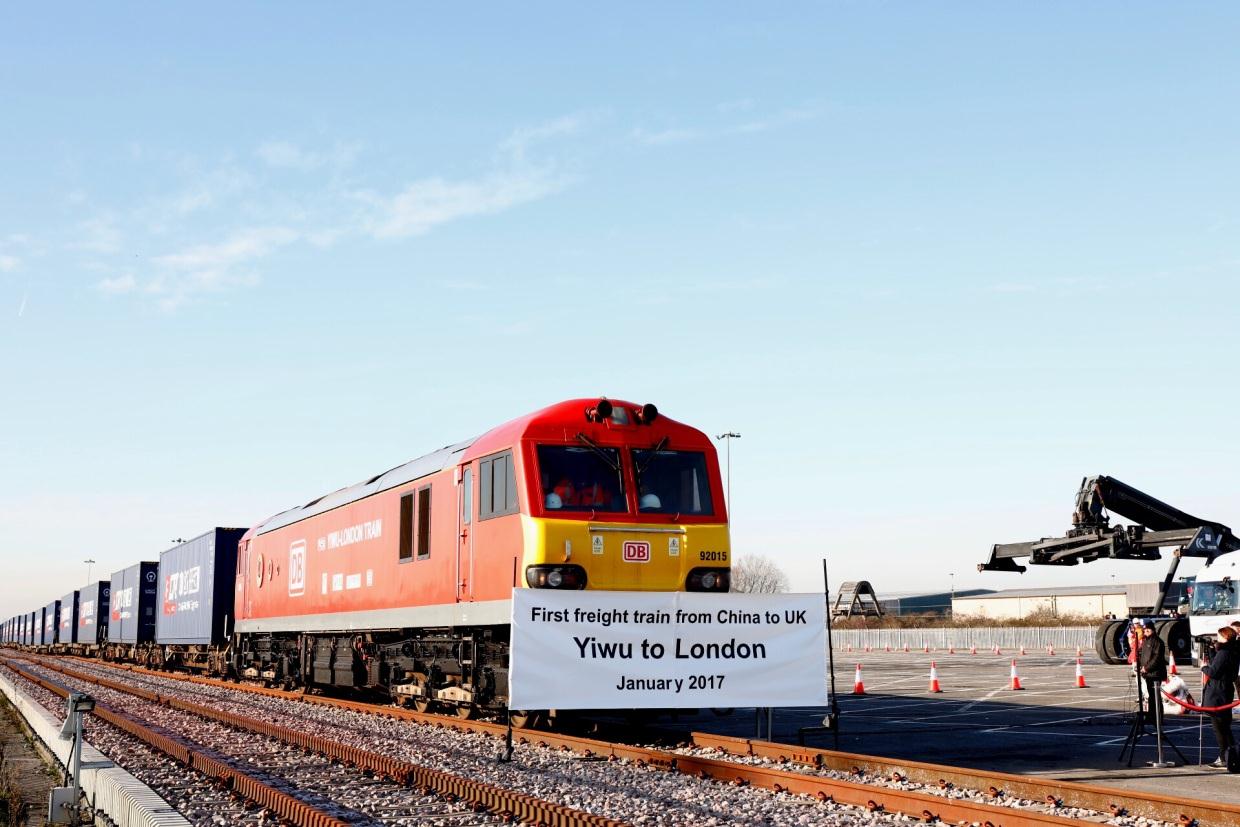The fanfare surrounding the pioneering China-Europe container express train that completed a one-way journey between January 1-18, 2017, is only partially warranted. Frictions abound over issues of interoperability of railway gauges and the diplomacy of connectivity as China pushes ahead with its massive Belt and Road Initiative.
The first transcontinental railway train between China and Europe arrived in London on January 18, 2017, exactly 18 days after it began its journey of 12,000 kilometres from Yiwu in eastern Zhejiang province, with its cargo of garments, bags and other consumer goods. The train, carrying 24 containers pulled by a German Deutsche-Bahn locomotive for its final leg, transited Kazakhstan, Russia, Belarus, Poland, Germany, Belgium and France before arriving in Britain. A comparable journey by sea would take 30 days or more – though it could be carrying a staggering 20,000 containers.
The steel railroad across the Eurasian heartland symbolizing the new overland Silk Road – officially known as the Silk Road Economic Belt – partly realizes the Belt and Road Initiative vision of China, and includes the many high-speed rail projects embraced by much of Asia in the past decade. While the pioneer freight train service was welcomed with much fanfare in Great Britain and China, in reality, a number of obstacles lie on the less than smooth Silk Road.

Different gauges and operators
Several factors currently limit the effectiveness of the railway’s potential in achieving Beijing’s goals. The dozens of existing rail links are not actually inter-connected at the moment. The rail systems in Kazakhstan, Russia, and Belarus use a wide gauge of 1.52 metres, a Soviet legacy, while the Chinese and European systems use a standard gauge of 1.435 metres.
This means that the cargo has to be physically transferred between trains whenever crossing between the two regions of gauges, which occurs at least twice during the journey. Despite the efforts of China or its Swiss contractor in managing travel time, additional costs would be unavoidable, and those Chinese products transported through rail would be in an inferior position in the market, in contrast to the volume conveyed through shipping.
Transferring cargo inevitably increases travel time and encourages the use of freight in standard containers, while discouraging transportation of bulky cargo such as agricultural crops and some types of heavy machinery. Those kinds of bulk cargo may be more competitive for landlocked countries to trade rather than manufactured or processed merchandise in containers. Intercontinental freight services have therefore not significantly improved the geo-economic position of those landlocked countries in the global market.
Currently, rolling stocks of variable gauge axles (VGA) for trains running on different gauges, especially transferring between the standard and wide gauges, are available in several European countries, including freight services. However, such expensive and complicated designs, mainly reserved for passenger trains, remain impractical for numerous freight trains and do not present an economic solution for China.
Although China may introduce VGA technology for local manufacturers to lower costs, the deployment of VGA would logically multiply refurbishment and transportation costs on the entire overland Silk Road.
Stumbling over the Soviet-era gauge system
Technically, the rail lines in the former Soviet republics could be transformed into a dual gauge system but that would mean higher costs both in the initial modifications and in the ensuing maintenance. Apart from tracks, different technical criteria, such as signal and electrical systems as well as standards of curves and slopes, make dual-gauge construction more difficult than adding one rail.
Beijing may not be willing to shoulder the expense. Furthermore, the wide gauge system was designed by Tsarist Russia to deny any potential foreign invader any logistical convenience. This fact remains a significant strategic concern.
Therefore, the governments which use the wide gauge may not want to abandon this arrangement, as the standard gauge tracks connect not only to China but also to Western Europe.
Diplomacy of connectivity
The dependence upon transferability between different rail systems also means that ‘diplomatic grease’ must be applied all along the new Silk Road. Sovereign railroad authorities must cooperate in approving licences, coordinating timetables, arranging adequate engines and other operational matters for the transfer of cargo and rolling stock. National and privatized rail companies ought to establish reliable and open protocols for communication regarding not only cargo transfer but also safety regulations.
Finally, the political assurance of uninterrupted rail transit must be guaranteed as far as possible if business interest is to be sustained. This may be a great deal to ask for considering that Central Asian states still have to consolidate their governance in regard to containing separatist movements, insurgencies and the rule of law. If the new Silk Road is to live up to its promise, diplomatic grease is the final necessary and sufficient ingredient.
For now, it looks like the other half of Belt and Road Initiative – the Maritime Silk Road – could have a relatively smoother sail. It will have to admit transit by ships of all registrations and ownerships, and on internationally recognized waters through the South China Sea, the Straits of Malacca through the Indian Ocean and Mediterranean Sea. It also has to retain a more democratic, flexible and politically accommodating edge over rail transport through the Eurasian heartland.
For politicians, citizens, businessmen and rail companies alike, the new Silk Road requires much more work to establish its credentials as a credible alternative to the time-honoured efficacy of maritime trade transit. On a slightly more positive note, the new services would suggest tighter and shorter direct rail links between China and its trading partners in the Shanghai Cooperation Organization (SCO), which may prove more crucial for the ultimate feasibility of the Belt and Road Initiative.
By Wu Shang-su and Alan Chong
Nanyang Technological University | Singapore
Wu Shang-su is a research fellow in the military studies programme, and Alan Chong is an associate professor with the Centre for Multilateralism Studies, both within the S. Rajaratnam School of International Studies (RSIS), Nanyang Technological University, Singapore.




